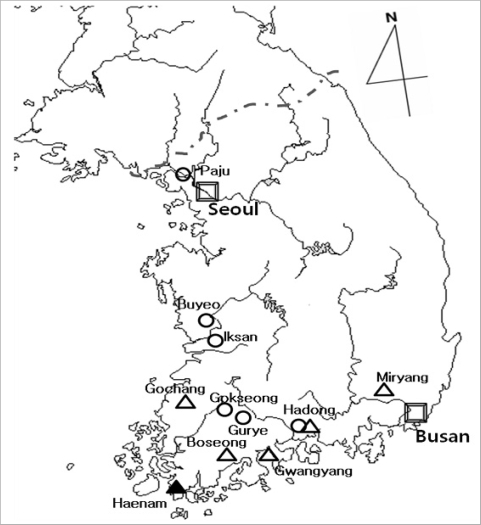Since the 1970s, the population density and the infection rate of crayfish and freshwater crabs with metacercariae of P. westermani have decreased drastically and continuously in many endemic areas. However, paragonimiasis patients still appear in Korea, and the major source of infection is presumed eating soybean sauced freshwater crabs (Kejang). Infection status of freshwater crab and crayfish with metacercariae of P. westermani is an important epidemiological index which represents the status of human infection sources [1-3]. It is required to estimate the importance of freshwater crabs as an infection source of human paragonimiasis in Korea to manage the disease.
In order to estimate the current status of P. westermani transmission by the crabs or crayfish in Korea, we examined the intermediate hosts for the metacercariae from October 2007 to October 2008. A total of 363 freshwater crabs (Eriocheir japonicus) from 10 localities and 31 crayfish (Cambaroides similis) from 6 localities were collected. The collection sites were selected according to geographical distribution (Fig. 1). The freshwater crabs and crayfish were brought to the laboratory and were examined for the metacercariae under a stereomicroscope using the crush method.
All of the 363 freshwater crabs were negative for P. westermani metacercariae (Table 1) which suggests that transmission of the metacercariae by freshwater crabs is rare and that a larger sample size is needed to detect metacercaria carrying crabs. In 1990, 11.8% of crabs purchased at markets in Seoul were positive with a mean of 2.1 metacercariae per positive crab [3]. In the markets, wild and aquacultured crabs are sold together but wild crabs have more risk of the transmission than aquacultured ones do because they have more chances of contact with the first intermediate host. Wild crabs are now produced more than before because of improved preservation of the environment in Korea. However, it is now becoming difficult to detect infected crabs in markets as is observed in this study. This finding suggests that transmission of Paragonimus by freshwater crabs is very rare in Korea compared to that in 1990s [3]. Nonetheless, scores of new paragonimiasis patients appear over the country every year and, therefore, there must be infected crabs at a very low frequency. In this context, further studies employing large number of wild crabs are necessary.
The crayfish collected at Haenam, Jeollanam-do were positive for metacercariae (Table 2; Fig. 1). The number of the metacercariae per crayfish ranged from 8 to 59, with a mean of 28.4. For years, transmission of P. westermani metacercariae by crayfish has only been observed at this locality [4-6]. The life cycle maintenance by crayfish may be enzootic rather than endemic.
In conclusion, P. westermani metacerariae are still transmitted by crayfish enzootically in southern Korea, and freshwater crabs may transmit the metacercariae on rare occasions.







